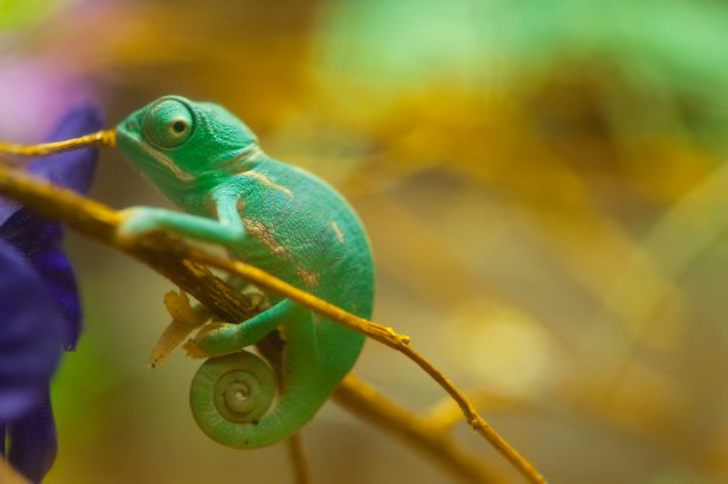Hello ladies and gents this is the Viking telling you that today we are talking about
Colourful Facts About Chameleons
You probably know that these lizards can change their skin colour, but they’ve got plenty of other special tricks as well. In fact, they might be the world’s most talented reptiles. Chameleons can shoot out their tongues at alarming speeds, use their tails as extra limbs, and even see in two different directions at once. Impressive, no?
1. THEIR FEET WORK LIKE SALAD TONGS.
Most lizards have fairly unremarkable feet. In the majority of species, they're comprised of four to five toes that can move independently of each other—just as ours do. But evolution has taken chameleon limbs in a very different direction. A chameleon’s foot consists of two fleshy pads that oppose each other. One pad contains three digits that are fused together while the other has two fused digits.
Up in the tree canopies where they live, these feet come in handy. Like a set of pincers, the opposing pads on each foot firmly clamp down onto vines and branches. Also, whereas most lizards have sprawling limbs, chameleons usually hold their legs almost directly underneath their bodies. This gives them an athletic gait for a modern reptile—walking this way keeps the center of gravity directly above the feet, which helps the animals stay balanced.
2. ALMOST HALF OF ALL KNOWN SPECIES LIVE IN MADAGASCAR.
Currently, there are around 200 different chameleon species, 44 percent of which can be found on Madagascar—leading some experts to wonder if the whole chameleon family originally evolved there (although a modern analysis deemed mainland Africa a more likely origin point). Elsewhere in the world, some members of this incredible group occur naturally in India, Asia minor, southern Europe, and mainland Africa.
3. CHAMELEONS VARY WILDLY IN TERMS OF SIZE.
In 2012, researchers discovered a new species of chameleon that—as of this writing—is the smallest on record. Known as Brookesia micra, the diminutive animal dwells on Nosy Hara, an islet off the coast of Madagascar. The diurnal lizard’s maximum adult length is only an inch, and juveniles can fit on the head of a match. (Sure, it's a cliche, but ... really. They can.) Meanwhile, mainland Madagascar is home to the two largest chameleons on record: the Oustalet’s chameleon and the Parson’s chameleon, each of which can grow up to 27 inches.
4. THEY MAINLY CHANGE COLOUR IN ORDER TO COMMUNICATE OR REGULATE BODY TEMPERATURE.
Contrary to popular belief, when a chameleon changes its skin color, the animal usually isn’t trying to camouflage itself by blending into the environment. More often, this remarkable ability is used as a way of controlling its body temperature. By lightening their skin, chameleons can cool themselves down, since lighter colors are better at reflecting the sun’s rays. On the other hand, adopting a dark complexion is a good way to warm up when it gets chilly outside.
Another primary function of color change is communication: Altering skin tone can let potential mates or rivals know what’s on your mind. For example, a female common chameleon (Chamaeleo chamaeleon) displays bright yellow spots when she’s ready to mate. Afterwards, she’ll darken her skin tone and show off blue and yellow spots to inform nearby males to stay away. (Angry hisses also help get the point across.)
Males, too, wear their emotions on their skin. When two bull graceful chameleons (Chamaeleo gracilis) cross paths, their skins become paler and more heavily spotted. Faced with the same situation, a pair of male warty chameleons (Furcifer verrucosus) will turn bright blue and green—but only on the lower half of their bodies.
When such displays aren’t enough, many males won’t shy away from physical confrontation. Amazingly, it looks like variations in skin color might predict the outcome of these squabbles before they happen. In 2013, Russell Ligon and Kevin McGraw of Arizona State University monitored 45 encounters between captive veiled chameleons (Chamaeleo calyptratus—pictured above). Before engaging with each other, males of this species show off the vibrant stripes on their sides. Both lizards intentionally brighten these up as a way to demonstrate their health while also making themselves look bigger. Ligon and McGraw discovered that—in most cases—any resulting fight was won by whichever combatant had brighter and more rapidly-changing stripes.
5. SKIN CRYSTALS ENABLE THEM TO CHANGE COLOUR AT WILL.
Until recently, scientists thought that the reptiles changed colour by manipulating the pigments inside their skin cells. But it's much more complicated. In 2015, scientists at the University of Geneva took a close look at the skin of the male panther chameleon (Furcifer pardalis) and discovered two layers of specialized cells lying under the creature’s hide that were loaded with tiny nanocrystals—the key to a chameleon’s colour-changing prowess.
The name of the game is reflection. When a male panther chameleon is relaxed, the cells containing its crystals are held closely together. In this position, they reflect blue light, which—when filtered through yellow skin pigments—makes the animal look green. Somehow, chameleons can expand and reduce the distance between those nanocrystals. By spreading them farther apart, the reptiles cause their crystals to reflect yellow or red light. The skin’s apparent colour then changes accordingly.
and as always have a chilled day from the Viking

Comments
Post a Comment